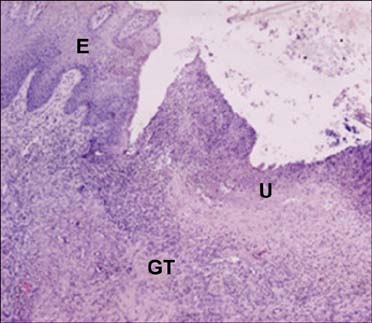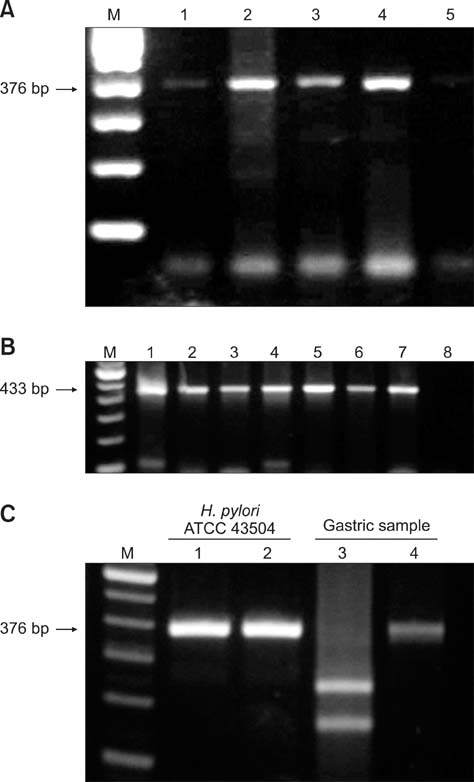J Vet Sci.
2010 Sep;11(3):221-225. 10.4142/jvs.2010.11.3.221.
Detection of Helicobacter spp. in gastric, fecal and saliva samples from swine affected by gastric ulceration
- Affiliations
-
- 1Department of Biopathological Science and Hygiene of Food and Animal Production, Faculty of Veterinary Medicine - University of Perugia, Via San Costanzo 4, 06126 Perugia, Italy. patrizia.casagrandeproietti@unipg.it
- 2Division of Avian Diseases, Kimron Veterinary Institute, Bet Dagan 50250, P.O.B. 12, Israel.
- KMID: 1093496
- DOI: http://doi.org/10.4142/jvs.2010.11.3.221
Abstract
- The aim of this study was to evaluate the presence of Helicobacter (H.) spp. in swine affected by gastric ulceration. Stomachs from 400 regularly slaughtered swine were subjected to gross pathological examination to evaluate the presence of gastric ulcers. Sixty-five samples collected from ulcerated pars esophagea and 15 samples from non-ulcerated pyloric portions were submitted to histopathological and molecular analyses, to detect Helicobacter spp., H. suis and H. pylori by PCR. Feces and saliva swabs were also collected from 25 animals in order to detect in vivo the presence of Helicobacter spp.. Gastric ulcers were detected in 373 cases (93%). The presence of ulcers in association with inflammatory processes was further confirmed by histological examination. Forty-nine percent (32/65) of the ulcerated esophageal portions as well as 53% (8/15) of the non-ulcerated pyloric portions were positive for Helicobacter spp. by PCR. The Helicobacter spp. positive samples were also positive for H. suis, while H. pylori was not detected. These results were confirmed by restriction enzyme analysis. With regard to feces and saliva samples, 15/25 (60%) and 16/25 (64%) were positive for Helicobacter spp. PCR, respectively but all were negative in H. suis and H. pylori specific PCR.
Keyword
MeSH Terms
Figure
Reference
-
1. Ayles HL, Friendship RM, Ball RO. Effect of dietary particle size on gastric ulcers, assessed by endoscopic examination, and relationship between ulcer severity and growth performance of individually fed pigs. Swine Health Prod. 1996. 4:211–216.2. Baele M, Decostere A, Vandamme P, Ceelen L, Hellemans A, Mast J, Chiers K, Ducatelle R, Haesebrouck F. Isolation and characterization of Helicobacter suis sp. nov. from pig stomachs. Int J Syst Evol Microbiol. 2008. 58:1350–1358.
Article3. Baldwin DN, Shepherd B, Kraemer P, Hall MK, Sycuro LK, Pinto-Santini DM, Salama NR. Identification of Helicobacter pylori genes that contribute to stomach colonization. Infect Immun. 2007. 75:1005–1016.
Article4. Barbosa AJA, Silva JCP, Nogueira AMMF, Paulino E, Miranda CR. Higher incidence of Gastrospirillum sp. in swine with gastric ulcer of the pars oesophagea. Vet Pathol. 1995. 32:134–139.
Article5. Choi YK, Han JH, Joo HS. Identification of novel Helicobacter species in pig stomachs by PCR and partial sequencing. J Clin Microbiol. 2001. 39:3311–3315.
Article6. De Groote D, van Doorn LJ, Ducatelle R, Verschuuren A, Haesebrouck F, Quint WG, Jalava K, Vandamme P. 'Candidatus Helicobacter suis', a gastric helicobacter from pigs, and its phylogenetic relatedness to other gastrospirilla. Int J Syst Bacteriol. 1999. 49:1769–1777.
Article7. Dore MP, Bilotta M, Vaira D, Manca A, Massarelli G, Leandro G, Atzei A, Pisanu G, Graham DY, Realdi G. High prevalence of Helicobacter pylori infection in shepherds. Dig Dis Sci. 1999. 44:1161–1164.8. Dunn BE, Cohen H, Blaser MJ. Helicobacter pylori. Clin Microbiol Rev. 1997. 10:720–741.
Article9. Fox JC. Non-human reservoirs of Helicobacter pylori. Aliment Pharmacol Ther. 1995. 9:Suppl. 93–103.10. Friendship RM. Straw BE, Zimmerman JJ, D'Allaire S, Taylor DJ, editors. Gastric ulcer. Disease of Swine. 2006. 9 th ed. Ames: Blackwell;891–900.11. Grasso GM, Ripabelli G, Sammarco ML, Ruberto A, Iannitto G. Prevalence of Helicobacter-like organisms in porcine gastric mucosa: a study of swine slaughtered in Italy. Comp Immunol Microbiol Infect Dis. 1996. 19:213–217.
Article12. Guise HJ, Carlyle WWH, Penny RHC, Abbott TA, Riches HL, Hunter EJ. Gastric ulcers in finishing pigs: their prevalence and failure to influence growth rate. Vet Rec. 1997. 141:563–566.
Article13. Haesebrouck F, Pasmans F, Flahou B, Chiers K, Baele M, Meyns T, Decostere A, Ducatelle R. Gastric Helicobacters in domestic animals and nonhuman primates and their significance for human health. Clin Microbiol Rev. 2009. 22:202–223.
Article14. Harding JCS, Clark EG, Strokappe JH, Willson PI, Ellis JA. Postweaning multisystemic wasting syndrome: Epidemiology and clinical presentation. Swine Health Prod. 1998. 6:249–254.15. Hänninen ML, Kärenlampi RI, Koort JM, Mikkonen T, Björkroth KJ. Extension of the species Helicobacter bilis to include the reference strains of Helicobacter sp. flexispira taxa 2, 3 and 8 and Finnish canine and feline flexispira strains. Int J Syst Evol Microbiol. 2005. 55:891–898.
Article16. Hänninen ML, Utriainen M, Happonen I, Dewhirst FE. Helicobacter sp. flexispira 16S rDNA taxa 1, 4 and 5 and Finnish porcine Helicobacter isolates are members of the species Helicobacter trogontum (taxon 6). Int J Syst Evol Microbiol. 2003. 53:425–433.
Article17. Hellemans A, Chiers K, Decostere A, De Bock M, Haesebrouck F, Ducatelle R. Experimental Infection of Pigs with 'Candidatus Helicobacter suis'. Vet Res Commun. 2007. 31:385–395.
Article18. Hellemans A, Chiers K, De Bock M, Decostere A, Haesebrouck F, Ducatelle R, Maes D. Prevalence of 'Candidatus Helicobacter suis' in pigs of different ages. Vet Rec. 2007. 161:189–192.
Article19. Henry SC. Gastric ulcers. Feed management is top priority for prevention. Large Animal Vet. 1996. 8–11.20. Krakowka S, Eaton KA, Rings DM. Occurrence of gastric ulcers in gnotobiotic piglets colonized by Helicobacter pylori. Infect Immun. 1995. 63:2352–2355.
Article21. Krakowka S, Ellis J. Reproduction of severe gastroesophageal ulcers (GEU) in gnotobiotic swine infected with porcine Helicobacter pylori-like bacteria. Vet Pathol. 2006. 43:956–962.
Article22. Lage AP, Godfroid E, Fauconnier A, Burette A, Butzler JP, Bollen A, Glupczynski Y. Diagnosis of Helicobacter pylori infection by PCR: comparison with other invasive techniques and detection of cagA gene in gastric biopsy specimens. J Clin Microbiol. 1995. 33:2752–2756.
Article23. Melnichouk SI, Friendship RM, Dewey CE, Bildfell RJ, Smart NL. Helicobacter-like organisms in the stomach of pigs with and without gastric ulceration. Swine Health Prod. 1999. 7:201–205.24. Mendes EN, Queiroz DMM, Rocha GA, Nogueira AMMF, Carvalho ACT, Lage AP, Barbosa AJA. Histopathological study of porcine gastric mucosa with and without a spiral bacterium ("Gastrospirillum suis"). J Med Microbiol. 1991. 35:345–348.
Article25. Moyaert H, Pasmans F, Ducatelle R, Haesebrouck F, Baele M. Evaluation of 16S rRNA gene-based PCR assays for genus-level identification of Helicobacter species. J Clin Microbiol. 2008. 46:1867–1869.
Article26. Park JH, Lee BJ, Lee YS, Park JH. Association of tightly spiraled bacterial infection and gastritis in pigs. J Vet Med Sci. 2000. 62:725–729.
Article27. Park JH, Seok SH, Cho SA, Baek MW, Lee HY, Kim DJ, Park JH. The high prevalence of Helicobacter sp. in porcine pyloric mucosa and its histopathological and molecular characteristics. Vet Microbiol. 2004. 104:219–225.
Article28. Queiroz DMM, Rocha GA, Mendes EN, De Moura SB, De Oliveira AMR, Miranda D. Association between Helicobacter and gastric ulcer disease of the pars esophagea in swine. Gastroenterology. 1996. 111:19–27.
Article29. Riley LK, Franklin CL, Hook RR Jr, Besch-Williford C. Identification of murine helicobacters by PCR and restriction enzyme analyses. J Clin Microbiol. 1996. 34:942–946.
Article30. Robertson ID, Accioly JM, Moore KM, Driesen SJ, Pethick DW, Hampson DJ. Risk factors for gastric ulcers in Australian pigs at slaughter. Prev Vet Med. 2002. 53:293–303.
Article31. Roosendaal R, Vos JH, Roumen T, van Vugt R, Cattoli G, Bart A, Klaasen HL, Kuipers EJ, Vandenbroucke-Grauls CM, Kusters JG. Slaughter pigs are commonly infected by closely related but distinct gastric ulcerative lesion-inducing gastrospirilla. J Clin Microbiol. 2000. 38:2661–2664.
Article32. Sgalés J, Sitjar M, Domingo M, Dee S, Del Pozo M, Noval R, Sacristan C, De las Heras A, Ferro A, Latimer K. First report of post-weaning multisystemic wasting syndrome in pigs in Spain. Vet Rec. 1997. 141:600–601.33. Szeredi L, Palkovics G, Solymosi N, Tekes L, Méhesfalvi J. Study on the role of gastric Helicobacter infection in gross pathological and histological lesions of the stomach in finishing pigs. Acta Vet Hung. 2005. 53:371–383.
Article34. Thomson MA, Storey P, Greer R, Cleghorn GJ. Canine-human transmission of Gastrospirillum hominis. Lancet. 1994. 343:1605–1607.35. Van den Bulck K, Decostere A, Baele M, Driessen A, Debongnie JC, Burette A, Stolte M, Ducatelle R, Haesebrouck F. Identification of non-Helicobacter pylori spiral organisms in gastric samples from humans, dogs, and cats. J Clin Microbiol. 2005. 43:2256–2260.
Article
- Full Text Links
- Actions
-
Cited
- CITED
-
- Close
- Share
- Similar articles
-
- Detection of Helicobacter pylori and BabA (Blood-group Antigen Binding Adhesin) in Saliva and Gastric Tissue by Polymerase Chain Reaction
- Nested Polymerase Chain Reaction Assay of Helicobacter pylori in Saliva
- Detection of Helicobacter Species from Korean Patients with Gallstones Using Polymerase Chain Reactions
- Microbial Profile of the Stomach: Comparison between Normal Mucosa and Cancer Tissue in the Same Patient
- Survey of Helicobacter infection in domestic and feral cats in Korea



